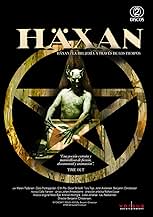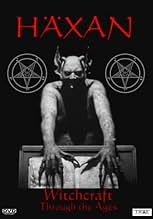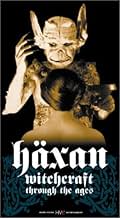VALUTAZIONE IMDb
7,6/10
18.294
LA TUA VALUTAZIONE
Documentario fittizio che mostra l'evoluzione della stregoneria, dalle sue radici pagane alla sua confusione con l'isteria nell'Europa moderna.Documentario fittizio che mostra l'evoluzione della stregoneria, dalle sue radici pagane alla sua confusione con l'isteria nell'Europa moderna.Documentario fittizio che mostra l'evoluzione della stregoneria, dalle sue radici pagane alla sua confusione con l'isteria nell'Europa moderna.
- Regia
- Sceneggiatura
- Star
Elisabeth Christensen
- En ældre bondekone
- (as Elizabeth Christensen)
- …
John Andersen
- Chief Inquisitor
- (as Johs Andersen)
Emmy Schønfeld
- Marie, the Seamstress
- (as Emmy Schönfeld)
Recensioni in evidenza
This film gives us a thoughtful look at the horrifying potential of fear, ignorance and superstition. I have to say I admire the courage Benjamin Christensen showed in making this film which not only must have offended the sensibilities of the time for the obvious reasons but also because it dared to champion reason over superstition as a way of explaining things which we do not fully understand. This film resonates with its message that those who judged others unjust may not have been just themselves.
The writer and director Benjamin Christensen discloses a historical view of the witches through the seven parts of this silent movie.
In the beginning, there is a slide-show alternating intertitles with drawings and paintings to illustrate the explanations of the behavior of pagan cultures and in the Middle Ages regarding their vision of demons and witches.
Then there is a dramatization of the situation of the witches in the Middle Ages, with the witchcraft and the witch-hunts.
Finally Benjamin Christensen compares the behavior of hysteria of the modern women of 1921 with the behavior of the witches in the Middle Ages, concluding that they are very similar.
"Häxan" is incredibly perfect for a for a 1922 movie. Like in a thesis, he exposes his point of view based in his study of the theme along the time. The reconstitution of the witches in the Middle Ages is amazing. The last part with the comparison with the hysteric women is funny in 2010, but it was the reality in 1921. My vote is eight.
Title (Brazil): "Häxan - A Feitiçaria Através dos Tempos" ("Häxan - The Witchcraft Through the Time")
Note: On 16 Aug 2018 I saw this film again.
In the beginning, there is a slide-show alternating intertitles with drawings and paintings to illustrate the explanations of the behavior of pagan cultures and in the Middle Ages regarding their vision of demons and witches.
Then there is a dramatization of the situation of the witches in the Middle Ages, with the witchcraft and the witch-hunts.
Finally Benjamin Christensen compares the behavior of hysteria of the modern women of 1921 with the behavior of the witches in the Middle Ages, concluding that they are very similar.
"Häxan" is incredibly perfect for a for a 1922 movie. Like in a thesis, he exposes his point of view based in his study of the theme along the time. The reconstitution of the witches in the Middle Ages is amazing. The last part with the comparison with the hysteric women is funny in 2010, but it was the reality in 1921. My vote is eight.
Title (Brazil): "Häxan - A Feitiçaria Através dos Tempos" ("Häxan - The Witchcraft Through the Time")
Note: On 16 Aug 2018 I saw this film again.
Directed by Scandinavian filmmaker Benjamin Christensen, Haxan' / Witchcraft Through the Ages' (1922) is a head-trippy silent film depicting black magic, witchcraft, and demonology from the middle ages to the 20th century. Shot and presented in documentary form, the film is more akin to a pseudo-scholarly lecture with moving visual aids. Not as intense or as shocking today as upon its initial release, the film is filled with nightmarish images that are certainly profane and explicit, but also humorous and downright silly.
Yes, sex goes hand-in-hand with Satan, and Christensen's flamboyant portrayal of the aforementioned character, complete with flicking, wanton tongue, drives home the point (well, that and a peppering of nudity). Unique to say the least, Haxan' is a rather weird curio of a film with some incredibly atmospheric, somewhat graphic images, esp. for that era.
The Criterion dvd includes the silent original and the 1968 re-release with an electric jazz-fusion score by Jean Luc Ponty and narration by William S. Burroughs. Burroughs' voice is a treat in itself, and the jazz-fusion score is absolutely frenetic. --- david ross smith
Yes, sex goes hand-in-hand with Satan, and Christensen's flamboyant portrayal of the aforementioned character, complete with flicking, wanton tongue, drives home the point (well, that and a peppering of nudity). Unique to say the least, Haxan' is a rather weird curio of a film with some incredibly atmospheric, somewhat graphic images, esp. for that era.
The Criterion dvd includes the silent original and the 1968 re-release with an electric jazz-fusion score by Jean Luc Ponty and narration by William S. Burroughs. Burroughs' voice is a treat in itself, and the jazz-fusion score is absolutely frenetic. --- david ross smith
The striking visuals would in themselves be sufficient reason to watch "Häxan", but in addition it is a thought-provoking feature that combines dark humor, some occasional chilling moments, and perceptive commentary on human nature. It's an unusual package and an unusual feature, and there aren't many films quite like it.
Simply on the surface, the series of unusual visuals and believable recreations of bygone eras would make for interesting viewing. Benjamin Christensen added a strong dose of the macabre to practically every scene, even in some of the smaller details that are only noticeable upon repeat viewings. Some of it is fascinating, some of it unsettling, all of it interesting.
But there is much more to "Häxan" than a mere collection of grotesque images and vignettes. Towards the end, in particular, the commentary becomes quite pointed. It is quite easy for anyone - film-maker, writer, commentator - to criticize and condemn the beliefs and practices of the Middle Ages or of any other long past era. But it is far more of a challenge to, as Christensen has done here, point out the sometimes devastating parallels to one's own era. It is always such a comforting fiction to believe that we are so much more enlightened than past generations have been, and yet it is rarely if ever true.
Christensen aptly illustrates the point that the inability to deal with the odd, the eccentric, and the unusual in our fellow beings is a perennial failing of humanity. Each generation simply devises its own means of stigmatizing and punishing those who cannot conform. (Nor is our own generation markedly better than was Christensen's.) This feature can certainly be viewed (either in the original silent version, or in the 1960s version with some spoken narration) for entertainment value alone. But it is even more pertinent in its observations on human nature. It's an often unsettling movie, with some images that might be bit too uncomfortable for some viewers. But for all that, it's an unusual and worthwhile viewing experience.
Simply on the surface, the series of unusual visuals and believable recreations of bygone eras would make for interesting viewing. Benjamin Christensen added a strong dose of the macabre to practically every scene, even in some of the smaller details that are only noticeable upon repeat viewings. Some of it is fascinating, some of it unsettling, all of it interesting.
But there is much more to "Häxan" than a mere collection of grotesque images and vignettes. Towards the end, in particular, the commentary becomes quite pointed. It is quite easy for anyone - film-maker, writer, commentator - to criticize and condemn the beliefs and practices of the Middle Ages or of any other long past era. But it is far more of a challenge to, as Christensen has done here, point out the sometimes devastating parallels to one's own era. It is always such a comforting fiction to believe that we are so much more enlightened than past generations have been, and yet it is rarely if ever true.
Christensen aptly illustrates the point that the inability to deal with the odd, the eccentric, and the unusual in our fellow beings is a perennial failing of humanity. Each generation simply devises its own means of stigmatizing and punishing those who cannot conform. (Nor is our own generation markedly better than was Christensen's.) This feature can certainly be viewed (either in the original silent version, or in the 1960s version with some spoken narration) for entertainment value alone. But it is even more pertinent in its observations on human nature. It's an often unsettling movie, with some images that might be bit too uncomfortable for some viewers. But for all that, it's an unusual and worthwhile viewing experience.
Imagine Tod Browning and Jean Cocteau making a film together and you might begin to get an idea of what you'll see in this film. It's rather disjointed in its storytelling but who cares? Where else can you see witches kissing the ass of Satan, boiling non-baptized babies, and giving birth to demons? Not to mention getting a full tour of the state-of-the-art in medieval torture devices! The film is really no more a documentary than "The Blair Witch Project" but certainly in the 1920s it must have been considered as such. Today, it makes for great Halloween viewing, giving us a chance to re-live the chilling legends that kept us afraid of the dark as children. The otherworldly glow of 1920s cinematography will retain each creepy image in your mind like musty cobwebs. A must-see for classic horror fans!
Lo sapevi?
- QuizThe Swedish film censors required numerous cuts in the film, before authorizing its release. Among the censored scenes were the closeup of the finger being removed from the hanged man's hand, the trampling of the cross in the witch's sabbath scene, the shot of the oozing infant held over a cooking pot, a closeup of a woman's face while she is on a torture rack, closeups of several instruments of torture being employed, and a shot of a demon embracing a nude woman (all these shots have since been restored to the film).
- BlooperThe skeletal horse-like creature wandering around during the Sabbath clearly is being moved about by a couple of stage hands, hidden under the blanket that covers its "body". The feet of the crew member at the front of the monster are visible in one shot.
- Citazioni
Title Card: Poor little hysterical witch! In the middle ages you were in conflict with the church. Now it is with the law.
- Curiosità sui creditiDirector Benjamin Christensen personally thanks his cinematographer and art director through the opening titles.
- Versioni alternativeWitchcraft Through the Ages (1968), the 76-minute version of Häxan, narrated by William S. Burroughs, with a soundtrack featuring Jean-Luc Ponty
- ConnessioniEdited into From Camille to Joan of Arc (1961)
I più visti
Accedi per valutare e creare un elenco di titoli salvati per ottenere consigli personalizzati
Dettagli
Botteghino
- Budget
- 2.000.000 SEK (previsto)
Contribuisci a questa pagina
Suggerisci una modifica o aggiungi i contenuti mancanti

![Guarda Trailer [OV]](https://m.media-amazon.com/images/M/MV5BNWUzNDFkOTAtYTdiZi00M2RiLWJiMjktZmZjM2RkNzNhMzBiXkEyXkFqcGdeQXRyYW5zY29kZS13b3JrZmxvdw@@._V1_QL75_UX500_CR0)




























